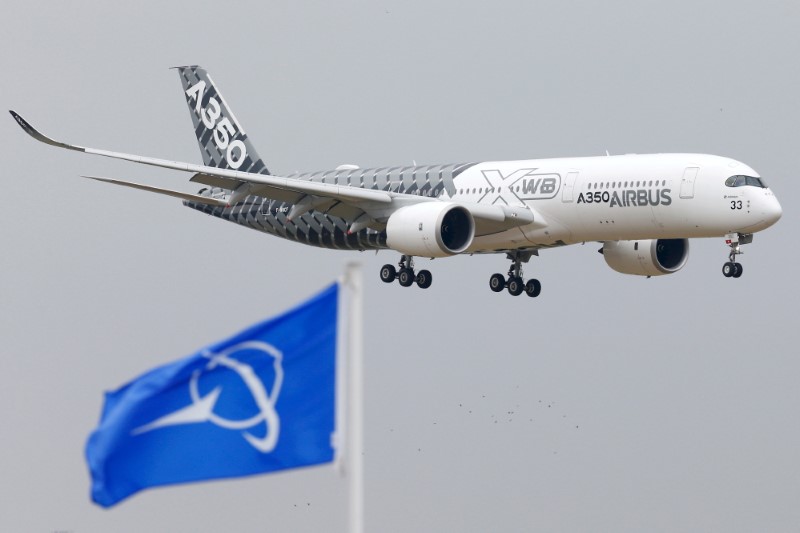By Tim Hepher, Andrea Shalal, David Shepardson and Philip Blenkinsop
(Reuters) -The United States and Europe are expected to announce a five-year suspension of tariffs in their 17-year-old dispute over aircraft subsidies on Tuesday, allowing them to focus on the threat posed by China’s nascent commercial aircraft industry, people familiar with the matter said.
A deal to pause the world’s largest corporate trade dispute would help U.S. planemaker Boeing and Europe’s Airbus, while granting relief to dozens of other industries affected by tit-for-tat tariffs that were suspended in March. They face a renewed trade war within weeks if there is no progress.
U.S. Trade Representative Katherine Tai discussed the dispute in her first face-to-face meeting with EU counterpart Valdis Dombrovskis on Monday ahead of Tuesday’s U.S.-EU summit, where China will also be a key topic. Tai travels to Britain on Wednesday.
The European Commission, which oversees EU trade policy, and the United States had vowed to find a solution by July 11 when the currently suspended transatlantic tariffs are due to resume.
Officials had targeted a permanent solution through a pair of treaties – one between the United States and European Union, the original parties, and another between Washington and London following Britain’s exit from the EU – on new ground rules for aerospace.
But reaching a detailed accord has proven complex, given nearly two decades of legal wrangling and thousands of pages of documents, said one source briefed on the talks.
A standstill agreement would push back the resumption of tariffs by years at a time when U.S. President Joe Biden has vowed to reset relations with European partners after four tumultuous years under former President Donald Trump.
Freezing the conflict over jet subsides, some of which have been rescinded or wound down, would give both sides more time to focus on broader agendas such as concerns over China’s state-driven economic model, several of the sources said.
The tariffs on $11.5 billion of goods were progressively imposed from 2019 after the United States and EU both won partial victories at the World Trade Organization over claims of unfair aid for Boeing and Airbus.
The dispute has dragged on since 2004 when the United States withdrew from a 1992 aircraft subsidy pact and took the EU to the WTO, claiming Airbus had managed to equal Boeing’s share of the jet market thanks in part to subsidized government loans.
The EU counter-sued over what it termed unfair R&D support and subsidized tax incentives for Boeing.
In recent months, top European, British and U.S. officials have engaged in intense discussions to settle the dispute and focus on other challenges, including China.
CHINA ‘ON RADAR’
Tai told Reuters in May she was optimistic about reaching a deal with Brussels, adding that the two sides needed to look at “the bigger question” of China’s ambitions to become a global player in the commercial aircraft industry.
The U.S. has floated a joint review of aerospace funding in non-market economies like China, two of the people said.
One of the sources said the two sides had agreed to increase information-sharing, but gave no further details.
“There’s no question that the rise of China’s aircraft industry is … on everybody’s proverbial radar,” U.S. Chamber of Commerce Senior Vice-President Marjorie Chorlins told reporters on Monday, noting what she described as China’s “heavy subsidization” of its industries.
She said settling the dispute would provide “a tremendous boost of goodwill” for broader U.S.-European ties.
Brussels and Washington remain at odds over steel and aluminum tariffs, but are expected at Tuesday’s summit to set a Dec. 1 deadline to end punitive tariffs related to the dispute, according to a draft communique seen by Reuters.
Like the United States, the EU has sparred with Beijing on trade and security this year. But its 27 nations could struggle to agree a common front on topics like aerospace.
In April, for example, Hungary blocked an EU statement criticizing China’s new Hong Kong security law, sparking a row over the right of member states to veto EU foreign policy.
The Chinese embassy in Washington had no immediate comment.
None of the parties agreed to comment on the talks.
HURDLES TO PERMANENT AGREEMENT
In a potentially key breakthrough, the United States had watered down opposition to the principle of future public loans for Airbus and removed its demand for compensation.
But its insistence on advance notice of any future public loans had triggered concerns among EU officials, who rejected giving Washington any veto power, people familiar with the talks said.
Even more critical is the benchmark to be used when deciding whether the interest on any future loans is market-compatible.
Under the 1992 subsidy pact, one third of a project could be financed by direct government support such as loans and cleared indirect R&D support up to 4% of a company’s revenue.
One option is to revisit that framework with market rules replacing subsidy quotas and a new cap on indirect R&D support.
Brexit has also complicated negotiations.
Britain and the United States came close to striking an aerospace agreement in December that could have forced the hand of Brussels in its own talks with Washington.
Britain’s ability to negotiate trade deals independently of the EU is central to its new “global Britain” stance. But its flexibility on Airbus is cramped by its role as one of four core nations involved in the planemaker, pre-dating its EU accession.
Airbus, which has 14,000 staff in Britain, has made plain work could shift abroad if the UK turns its back on aerospace.
(Reporting by Andrea Shalal, Philip Blenkinsop, David Shepardson, William James, Tim Hepher; Writing by Tim Hepher; Editing by Jane Merriman and Stephen Coates)


























